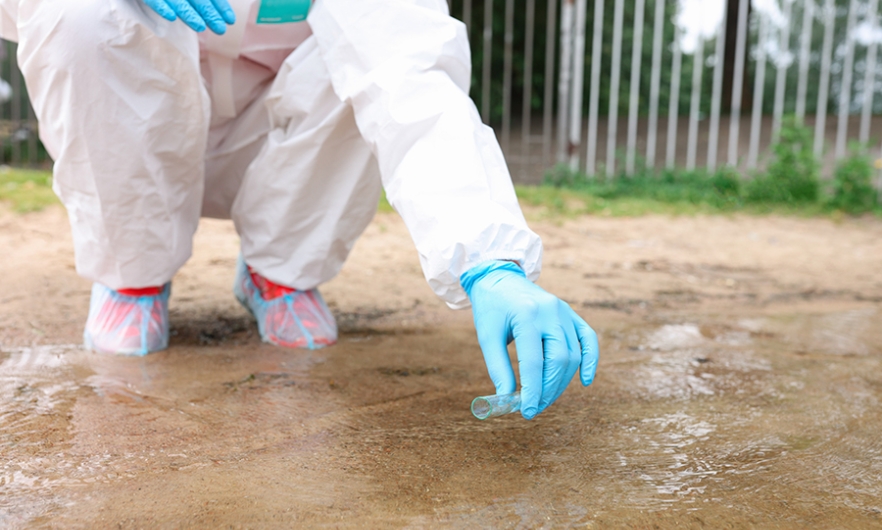New Low-Cost Rapid Field Diagnostic Tests for Pathogens ETEC, Shigella, and Cholera May Be the Future in Infectious Disease Outbreak Response and Surveillance
The reliable and easy-to-use tests cost a fraction of the price of lab-based tests and return results in only minutes instead of days

Researchers from the Department of International Health at the Johns Hopkins Bloomberg School of Public Health recently developed a new, highly sensitive, molecular diagnostic field assay that detects cholera from a stool or water sample in minutes. The reliable and easy-to-use tests cost a fraction of the price of lab-based tests, which can take days for results to become available. In addition to the new cholera assay, the Bloomberg School team has already used similar technology to develop rapid tests for both ETEC and Shigella. These new rapid, low-cost tests have the potential to drastically improve responses to disease outbreaks while also contributing to long-term surveillance that guides policies and future interventions.
The study detailing the development of the cholera assay was published in PLOS Neglected Tropical Diseases on February 6, 2023. It was led by Subhra Chakraborty, PhD, MPH '13, MSc, an associate scientist in the Department of International Health at the Bloomberg School.
What is the issue?
Infectious diseases are among the leading causes of death worldwide, and diarrheal diseases are the second leading cause of death in children under five years old. Diarrhea is a symptom of infection from pathogens, which are often spread through contaminated water or food sources. Enterotoxigenic E. coli (ETEC), Shigella spp. (Shigella), and Vibrio cholerae (cholera) are some of the most common causes of diarrhea-related disease in low-income countries. Globally, the burden of disease of these pathogens is incredibly high with an estimated 1.7 billion cases of childhood diarrheal disease each year.1
These diarrhea-causing pathogens are complex, and diagnostic tests to detect the pathogens are very elaborate and lengthy. Recent cholera outbreaks have increased in frequency, intensity, and duration, illuminating the need for the development of more effective surveillance, testing, and interventions. During cholera and other infectious disease outbreaks, it is critical to identify the source of contamination to prevent additional infections and initiate oral cholera vaccine campaigns, therefore having a fast and effective diagnostic test is lifesaving.
Why was this developed?
Traditionally the gold standard for the detection of cholera has relied on culture methods that require laboratory analysis of stool samples. While this method of detection is effective, it can take days to get results and thus is not an efficient process to detect disease during an outbreak, nor is it feasible for many areas where cholera is endemic or access to laboratories is limited. Rapid diagnostic tests have been developed to help mitigate lab access and timing difficulties, but there is a lack of consistency in the sensitivity and specificity of these tests leading to inaccurate results, further contributing to a lack of quick and effective cholera diagnostic methods, explains Chakraborty.
What makes this method different?
The development of the Rapid Loop-mediated Isothermal Amplification (LAMP) based Diagnostic Test, RLDT, addresses the gaps left by traditional diagnostic methods. The entire process was purposefully designed with ease of use, transport, and storage in mind to ensure its ability to be implemented in a variety of settings. The RLDT, which utilizes an isothermal nucleic acid amplification-based diagnostic assay method, has five key advantages.
- Testing is performed directly from a wet or dried stool sample or a contaminated water sample.
- The entire testing process is completed in approximately 1 hour from sample collection to results.
- Sample preparation takes less than 5 minutes, minimizing hands-on time.
- There is a high degree of specificity and sensitivity of results.
- Assay detects both O1 and cholera toxin genes which allows for quick detection if a new toxigenic strain emerges and can inform rapid response.
- The test kit is easy to use and self-contained.
- The kit includes all reagents and supplies required, crucial for use in low-resource settings to alleviate concerns about acquiring different reagents or materials.
- There is minimal biohazard waste generated allowing for ease of containment and management.
- No cold-chain or electricity required.
- The assay exists in a dry format where all reagents are lyophilized (freeze-dried).
- Results can be read using a handheld, battery-operated device.
- The tests serve as a point-of-care diagnostic tool in endemic settings, with the potential to be scaled up for rapid detection in outbreak settings.
Can this be used for other infectious diseases?
The Bloomberg team’s previous drive to develop new assays for ETEC and Shigella stemmed from the observed lack of point-of-care diagnostic tools in resource-limited regions. The implementation of the ETEC specific RLDT assay has already proven successful with a high degree of sensitivity in Zambia, where the diseases are endemic.
Overall, the RLDT process has proven to be a cost-effective screening tool for ETEC and Shigella when compared with the cost and infrastructure requirements associated with traditional testing methods.
What’s next?
There are currently field evaluations of the cholera RLDT in South Asian and African countries to determine its feasibility and performance in endemic settings. The RLDT assay for Shigella and ETEC is currently being implemented for disease surveillance in Zambia and Burkina Faso.
There is potential to use the RLDT assay in phase III Shigella vaccine trials in the future because it is a rapid, simple, and sensitive assay. Additionally, because Shigella cannot be detected through clinical presentations alone, the Shigella RLDT can be used for case detection and treatment as a point-of-care tool in health care facilities. Looking toward the future applications of this technology, there is potential for the RLDT platform to be expanded to other infectious diseases where a point-of-care assay is an urgent need and would help in overall disease detection, treatment, and surveillance.





